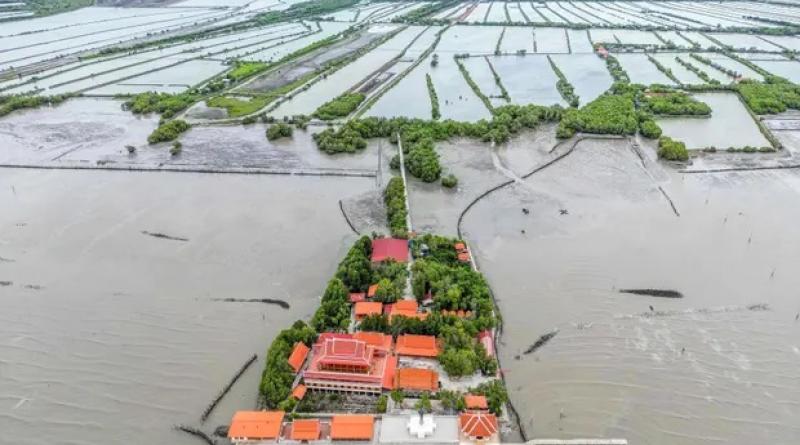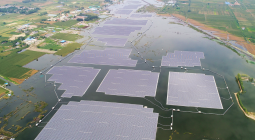Just four pupils left: how the sea rose up on a Thai village

From the corridor of Khun Samut school, it’s clear how far inwards the sea has crept. In the distance, beyond the still waters of neighbouring shrimp farms, sticks can be seen poking out of the blue. They were once electricity poles, powering the parts of the village that have since been submerged in the Bay of Bangkok.
Over recent decades, Ban Khun Samut Chin, a coastal village in Thailand’s Samut Prakan province, about 10km from the outskirts of Bangkok, has been slowly swallowed by the sea. The school, which is elevated on concrete stilts, has already been forced to retreat twice. Families have repeatedly moved their homes. Many have left altogether after finding work elsewhere. The population is getting smaller and smaller.
By lunchtime, Napat Ploykhao, 10, is happy to be reunited with his friend, Peerapab Butthong, 12, and is hungry after a morning spent learning biology. “I’m not lonely because Pee is here,” says Napat of his friend, who hands scraps of fried chicken to one of the school cats crouched below the table.
At the school, students are taught about issues such as the climate crisis, and take trips out to learn about conservation and understand the history of the village. “The school used to be out in the sea,” Napat says.
“Mangrove is very important to plant because it will stop the waves,” he adds. He helped plant mangroves during a project to rebuild the forests.
Mangroves, a natural defence against the strong waves and storm surges of the Gulf of Thailand, have been drastically reduced to make room for shrimp farms. This, combined with groundwater extraction, as well as the development of dams on the Chao Phraya River that runs through Bangkok, which has blocked the flow of sediment downstream, has aggravated the problem of coastal erosion.
The village has suffered the worst shoreline retreat in Thailand, with estimates suggesting between 1.1km and 2km have disappeared since the mid-1950s.
“I was born here, I have seen and can still see the changes happening,” says the village chief, Wisanu Kengsamat.
“Before there used to be 100 households, now it’s around 80. The population is halved,” says Wisanu, describing the changes he has seen over the past four decades.
Young people have to go outside the village to attend high school and often don’t come back. “For some families, they don’t have a house any more because of the erosion so they don’t have a space to live or even to make money,” says Wisanu. “If people can find work elsewhere – as a factory worker, office worker or a farmer – they will go.”
Those who stay have also become more dispersed as people have sought land in safer areas, says Wisanu.
Some students walk for up to an hour along embankments and bridges to get to school, says teacher Orrawan Kaewnum. “Normally, Thai schools start at 8.30am, and at 8am you have to be here and ready. But here we are flexible, we can’t fix the time. If it’s a rainy day, it can take a long time. When we see black clouds coming we close the school early.
“We are like small ants compared to nature,” adds Orrawan.
The village is on the frontlines of a battle against the climate emergency and rising sea levels, a threat that is accelerating globally. Over the past decade oceans rose by 4.62mm a year, and the crisis is worsening, prompting the UN secretary general to warn it could lead to “a mass exodus of entire populations on a biblical scale”.
Thailand, where about 17% of the population – 11 million people – live in coastal areas, is especially vulnerable.
Its capital, Bangkok, faces the compound risk of rising sea levels as well as heavy rainfall and water runoff.
The threat of rising sea levels often gets the least attention because it happens incrementally, says Wijitbusaba Marome, an assistant professor at the faculty of architecture and planning of Thammasat University.
“You may not see direct evidence of a disaster, or of people getting stuck in a traffic jam because of heavy rainfall. But it’s gradually affecting your livelihood.”
At Ban Khun Samut Chin, villagers have used donations, and worked with academics from Bangkok’s Chulalongkorn University to try to build protective structures. Over the past two decades they have planted 19.2 hectares (47 acres) of mangrove, and built bamboo fencing. Concrete poles have been installed in some areas to lessen the impact of the waves.
Wisanu says government support is needed so that they can protect the village, but this hasn’t been forthcoming.
Napat says he isn’t sure what he wants to be when he is older; it’s too much to think about, he says.
His grandmother, Wanna Mainuam, thinks he will remain in Ban Khun Samut Chin. Villagers can raise some revenue by opening their homes to tourists, or by hosting tour groups from schools or companies who want to learn about conservation. Already, Napat likes to take tourists to the temple at weekends and explain about the village, his grandmother says.
Fishing has become much harder, she says, but she thinks tourism could provide a future. People can visit and taste fresh seafood, she adds: “It’s a way for visitors to see the village people’s life.”
cover photo:The Buddhist temple surrounded by seawater with the Bangkok skyline visible in the distance. Photograph: Manan Vatsyayana/AFP/Getty Images




